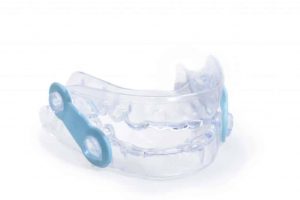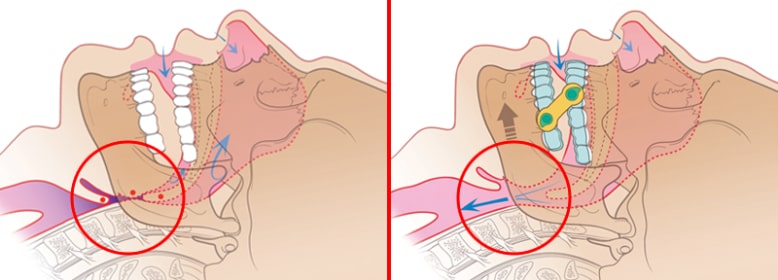An EMA oral appliance can provide significant relief and more peaceful sleep to patients suffering from snoring and sleep apnea. The device is available by prescription through authorized dental laboratories.
For detailed sleep appliance information about how the EMA appliance works and how to choose the right EMA lab, we spoke with Sean Parisien RDT, Laboratory Manager at Watersedge Dental Laboratory in Ottawa. Located outside Ottawa? No worries! We service Ontario and parts of Quebec. If you need a Belleville dental laboratory, Kemptville dental laboratory or a Kingston dental laboratory, contact us today.
What Is An EMA Appliance?
The name EMA stands for Elastic Mandibular Advancement appliance. An EMA appliance is a removable, non-invasive device for the treatment of snoring. The appliance advances the mandible via elastic straps bilaterally attached to buttons on the appliance, opening the airway to help patients stop snoring, or snore less. 
Basically, an EMA appliance will keep your mouth and airways open and clear. A variety of interchangeable elastic lengths and different elasticities for each length make the appliance easily adjustable by the dentist.
Watersedge produces two types of EMA appliances:
1. The standard bestselling EMA consists of two vacuum-formed shells that fit directly over the teeth for a small, lightweight anti-snoring appliance.
2. The thermoplastic EMA comprises two thermoplastic shells, allowing easier insertion and greater comfort for some patients; this version also has better fracture resistance due to the thermoplastic properties.
Who Needs An EMA Appliance?
Patients with snoring and low to moderate obstructive sleep apnea (OSA) may benefit from the use of an EMA appliance, if they have at least a partial set of natural teeth.
How It Works
People snore because their air passageway is slightly blocked. The EMA appliance works by pulling the jaw forward to open the airway and thus lessen snoring.

How To Obtain An EMA Appliance For Your Patients
If you are a physician or dental clinician treating a patient for sleep apnea, begin with a sleep study to determine if an oral appliance rather than a CPAP machine. Then the dental clinician must take maxillary and mandibular impressions, in either analog (physical impressions) or digital (intra-oral images) format.
Two bites are necessary: maximum intercuspation (MI) and a comfortable/protrusive bite. The latter is extremely important since the appliance will be holding the jaw in a forward position.
Send the impressions, together with a prescription for the appliance, to our lab.
How are EMA Appliances made?
1. The entire process of producing an EMA appliance in our lab takes around five days.
2. As a first step, we make models based on the impressions sent by the dental clinician.
3. Next, our skilled technicians apply vacuum-formed shells to the models to create the appliance itself.
4. The shells are trimmed and adjusted to a smooth and comfortable shape for the patient’s dental architecture.
5. We then apply the buttons (which will hold the elastics) in specific positions where they are best suited for the specific patient, on the posterior regions of the mandible and in the anterior region of the maxilla.
6. Bite pads are added to keep the patient’s bite open for three reasons: 1) to create an air pathway, 2) to help the patient’s mandible slide forward (protrude), 3) to allow a flat bruxism platform.
7. The acrylic used for the addition of the buttons and bite pads is trimmed and polished smooth.
8. The technician double-checks that all details of the appliance are appropriate for the patient.
9. Finally, in our QA department, we review the appliance to verify that it has been fabricated as prescribed and is in good standing order for the clinician to deliver to the patient.
What Are Potential Problems With The Process?
First, the impressions may have issues, including voids, distortions (pulls and drags), or double-takes. Second, a question may arise as to whether there will be adequate retention. When the patient has very short teeth with no undercuts, it can be difficult to keep the EMA in place.
If there is an issue, we will call the dentist and work with him/her to find a solution. This may be simply taking a new impression. Another possibility is producing a modified version of the appliance, in which case we will send some models to the dentist for review.
What Materials And Technology Do You Use?
Only three materials are utilized for the fabrication of EMA appliances — clear polypropylene sheets to make the shells, the buttons are copolymer acrylic, and polymethyl methacrylate (PMMA). All of these are BPA free.
In terms of technology, we use vacuum forming machines, digital scanners, and most importantly 3D printers to create a model of the patient’s jaw. (Models are sent to the prescribing dentists for their clinic use.)
How To Pick A Lab To Build Your EMA Appliances
First, look for a lab which is authorized by Myerson Tooth, owner of the EMA oral appliance patent.
It is important that the lab employ a large number of highly qualified and knowledgeable staff who are able to answer all questions in detail.
Consistency and quality are hugely important. The result may be a bit more expensive, but you have a guarantee that the appliance will be delivered on time in accordance with your schedule and will be of reliable quality.
Talk To Sean About Your EMA Needs!
Watersedge Dental Laboratory is certified by Myerson as an EMA provider. If you’re in need of a dental lab in Carleton Place, Ottawa or the rest of Ontario, give us a call!
In addition to our fabrication process, look to us for in-depth professional knowledge transfer regarding the product. We can assist you as a clinician, whether you are newly adding anti-snoring devices to your business or you have more technical questions.
Discuss your concerns with our knowledgeable team – Sean our Lab Manager, Alain our Ortho Department Head, or one of our highly-trained QA technicians. We are always available when a clinician is in need of information or help.